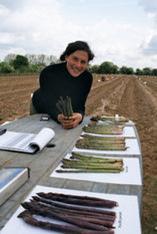
Trials which one day could alter the scale and shape of the English asparagus season have begun with the first steps taken by Hargreaves Plants.
Hargreaves’ product manager Jamie Petchell and technologist Marie-Laure Martin believe that, like the spears currently pushing their way through the sandy soil at West Bilney, Norfolk, this could be the tip of the iceberg.
Ultimately, says Petchell, massively higher yields and varieties grown specifically to extend both the early and late season are possible, but he warned that it will take time.
Asparagus harvesting is controlled by soil temperature. The current UK main volume season, got underway a fortnight earlier than last year because of near summer temperatures
The early spring produced unexpectedly good results from several of the current 240 varieties under test which might have been discarded, but as Petchell put it: "We are giving them a second chance in 20072008."
With others already identified they could become part of a new dimension, he added. "More and more of the crop is being grown under protection and while producing results, the industry is still on a learning curve to maximise the benefits. And this year with the earliest crop produced in Cornwall during March using heat generated by hot water pipes, who knows when the season could start?"
Already the eight week production cycle traditionally concluded in mid June is being questioned with the validation of AspireUK, for which Hargreaves holds the marketing rights.
Since the Asparagus Growers' Association workshop in March, Petchell revealed that around 35 percent of the total UK acreage has signed up to use the system.
The other aspect where there could one day be dramatic change lies in increasing marketable yields, which in the UK are in the region of two tonnes/hectare.
Hargreaves’ next step underway is to concentrate on the agronomy of the crop by assessing the use of larger crowns.
These are more expensive at some 20p plus each compared with 12p. "You would expect me to say that," he joked. "But we believe the reality is that getting a larger root structure into the ground when new beds are being laid couple be very beneficial. There would be a yield in the second year, rather having to wait three."
Trials began two years ago, evaluating four different crown sizes, but there could be a glimpse of the future when he revealed that using the largest seven tonnes/hectare ‘could be an achievable goal.’
Meanwhile although the original variety trials assessing yield, taste, colour and size will continue, a new one will get underway in 2008 based on the perceived 50 ‘winners’ at this stage chosen drawn from a range of countries including New Zealand, Canada, Italy, Germany and France. These continue to compete against the two UK standards Dutch Gijnlim and Backlim, which are still grown by 80 percent of producers.
"We are in it for the long haul," says Petchell, who two years ago predicted that multiples would sell asparagus by variety. Now he believes that asparagus could take on a new role being sold raw for salads.
And this has already hit the marks this season with Marks and Spencer’s decision to put up an exclusive purple variety on its shelves with just such a recommendation.
Hargreaves, with its international connections are keeping a close eye on developments in New Zealand, where a white styled supersweet has made an appearance.
If asparagus still has something of a mystery about it, the story is still unfolding, for instead of earthing it up to blanch the spear before it emerges, this crop is grown in the dark and harvested by pickers wearing miners' headgear.



